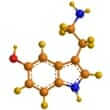Background
- The medicinally used part of licorice is the root and dried rhizome of the low-growing shrub Glycyrrhiza glabra. Currently, most licorice is produced in Greece, Turkey, and Asia.
- Licorice has been used in ancient Greece, China, and Egypt, primarily for gastritis (inflammation of the stomach) and ailments of the upper respiratory tract. Ancient Egyptians prepared a licorice drink for ritual use to honor spirits of the pharaohs. Its use became widespread in Europe and Asia for numerous indications.
- In addition to its medicinal uses, licorice has been used as a flavoring agent, valued for sweetness (glycyrrhizin, a component of licorice, is 50 times sweeter than table sugar). The generic name "glycyrrhiza" stems from ancient Greek, meaning "sweet root." It was originally used as flavoring for licorice candies, although most licorice candy is now flavored with anise oil. Licorice is still used in sub-therapeutic doses as a sweetening agent in herbal medicines, lozenges, and tobacco products (doses low enough that significant adverse effects are unlikely).
- Licorice has a long history of medicinal use in Europe and Asia. At high doses, there are potentially severe side effects, including hypertension (high blood pressure), hypokalemia (low blood potassium levels), and fluid retention. Most adverse effects have been attributed to the chemical component glycyrrhiza (or glycyrrhizic acid). Licorice can be processed to remove the glycyrrhiza, resulting in DGL (deglycyrrhizinated licorice), which does not appear to share the metabolic disadvantages of licorice.
References
- Amaryan G, Astvatsatryan V, Gabrielyan E, et al. Double-blind, placebo-controlled, randomized, pilot clinical trial of ImmunoGuard--a standardized fixed combination of Andrographis paniculata Nees, with Eleutherococcus senticosus Maxim, Schizandra chinensis Bail. and Glycyrrhiza glabra L. extracts in patients with Familial Mediterranean Fever. Phytomedicine 2003;10(4):271-285.
View Abstract - Arase Y, Ikeda K, Murashima N, et al. The long term efficacy of glycyrrhizin in chronic hepatitis C patients. Cancer 1997;79(8):1494-1500.
View Abstract - Armanini D, Castello R, Scaroni C, et al. Treatment of polycystic ovary syndrome with spironolactone plus licorice. Eur J Obstet Gynecol Reprod Biol 2007 Mar;131(1):61-7.
View Abstract - Chande N, Laidlaw M, Adams P, et al. Yo Jyo Hen Shi Ko (YHK) improves transaminases in nonalcoholic steatohepatitis (NASH): a randomized pilot study. Dig Dis Sci 2006 Jul;51(7):1183-9.
View Abstract - Cheng TO. Herbal interactions with cardiac drugs. Arch Intern Med 2000;160(6):870-871.
View Abstract - Cinatl J, Morgenstern B, Bauer G, et al. Glycyrrhizin, an active component of liquorice roots, and replication of SARS-associated coronavirus. Lancet 2003;361(9374):2045-2046.
View Abstract - Elinav E, Chajek-Shaul T. Licorice consumption causing severe hypokalemic paralysis. Mayo Clin Proc 2003;78(6):767-768.
View Abstract - Fujioka T, Kondou T, Fukuhara A, et al. Efficacy of a glycyrrhizin suppository for the treatment of chronic hepatitis C: a pilot study. Hepatol Res 2003;26(1):10-14.
View Abstract - Hinoshita F, Ogura Y, Suzuki Y, et al. Effect of orally administered shao-yao-gan-cao-tang (Shakuyaku-kanzo-to) on muscle cramps in maintenance hemodialysis patients: a preliminary study. Am J Chin Med 2003;31(3):445-453.
View Abstract - Kamei J, Nakamura R, Ichiki H, et al. Antitussive principles of Glycyrrhizae radix, a main component of the Kampo preparations Bakumondo-to (Mai-men-dong-tang). Eur J Pharmacol 2003;469(1-3):159-163.
View Abstract - Kobayashi H, Mizuno N, Teramae H, et al. The effects of Hochu-ekki-to in patients with atopic dermatitis resistant to conventional treatment. Int J Tissue React 2004;26(3-4):113-117.
View Abstract - Liu J, Manheimer E, Tsutani K, et al. Medicinal herbs for hepatitis C virus infection: a Cochrane hepatobiliary systematic review of randomized trials. Am J Gastroenterol 2003;98(3):538-544.
View Abstract - Strandberg TE, Andersson S, Jarvenpaa AL, et al. Preterm birth and licorice consumption during pregnancy. Am J Epidemiol 2002;156(9):803-805.
View Abstract - Tsukamoto S, Aburatani M, Yoshida T, et al. CYP3A4 inhibitors isolated from Licorice. Biol Pharm Bull 2005 Oct;28(10):2000-2.
View Abstract - van Uum SH. Liquorice and hypertension. Neth J Med 2005;63(4):119-120.
View Abstract







